Two Time-Tested Tools
This week I have worked substantially with two tools used in woodworking and sometimes in other materials like stone and plastic. One is definitively known as a rasp. Rasps come in various widths, lengths and shapes. Hand-made rasps, known as hand stitched, can be expensive. My favourites thus far are those made by Auriou of France; the one I rely on most is the Cabinet rasp. This rasp is flat on one side and round on the opposite face. The end follows a gradual boat shape culminating in a pleasing and useful point and for most of us these are the most useful and practical types regardless of size. Mine is now thirteen years old and it still cuts wood more than well; beautifully is the word, really. The smaller and narrower versions, maybe 1/2″ to 3/4″ wide and 6-8″ long, are excellent for tighter, smaller work, shaping handles and such. No matter the size, they are beautifully balanced in the hand and cut superbly efficiently.
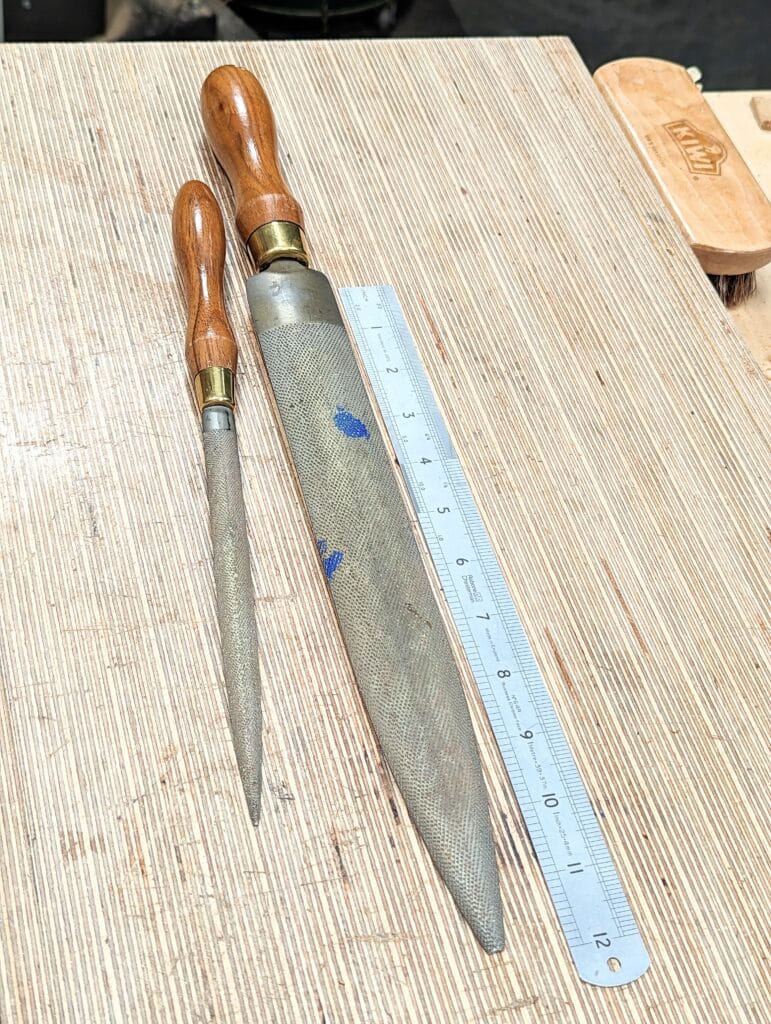
In the past, I generally suggested the four-in-hand rasp, the type used by farriers for trimming horse hooves after reshoeing horses. These are an almost decent starter rasp for tasks like shaping be that removing hard corners to curves as in spoon and spatula making, cutting boards and so on, but in recent years these rasps have come in with softer steel and fail to keep their edge for very long or are indeed are just flat poorly made, a facsimile of what was the industry standard. When a rasp loses its cutting edges it becomes a bruising implement bluntly attacking good wood to leave it more bruised than finely cut. I like the kind of ‘bite‘ and edge retention you get from the hand-stitched versions as with Auriou and Logier. My hope is that they will continue to survive and keep raising future generations of skilled rasp makers.
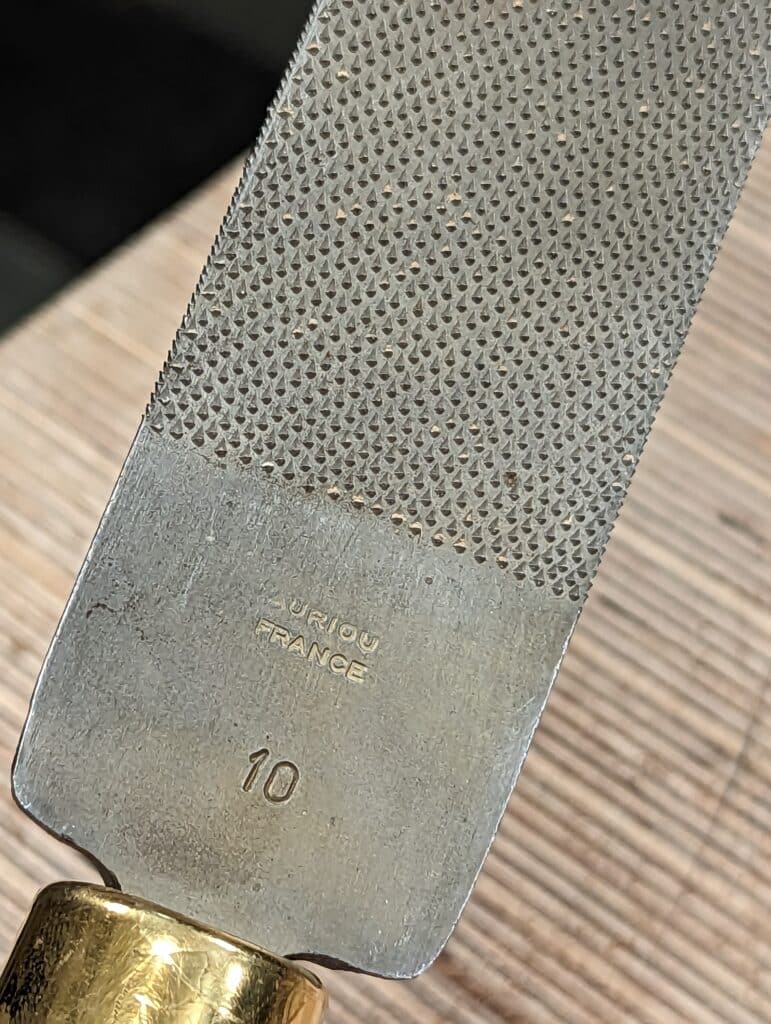
With regard to the four-in-hand rasp: what’s truly valuable is that you get four surfaces on the same rasp. They have no handle as the steel itself is the hold you get and what you have is good grip. The flat side gives you a half-length of actual rasp with the essential layers of barbed stitching while the other half of the length is essentially a file with finer cutting and smoothing ability. The reverse side is round and on this side, you again get the rasp and file but in the round so to speak. I am not sure why the best makers of rasps have not replicated a top-notch version of this tool — a 12-14″ long version with the boat-shaped ends would be a superbly useful tool and probably a best seller for them. Nudge, nudge! Well within their capacity.
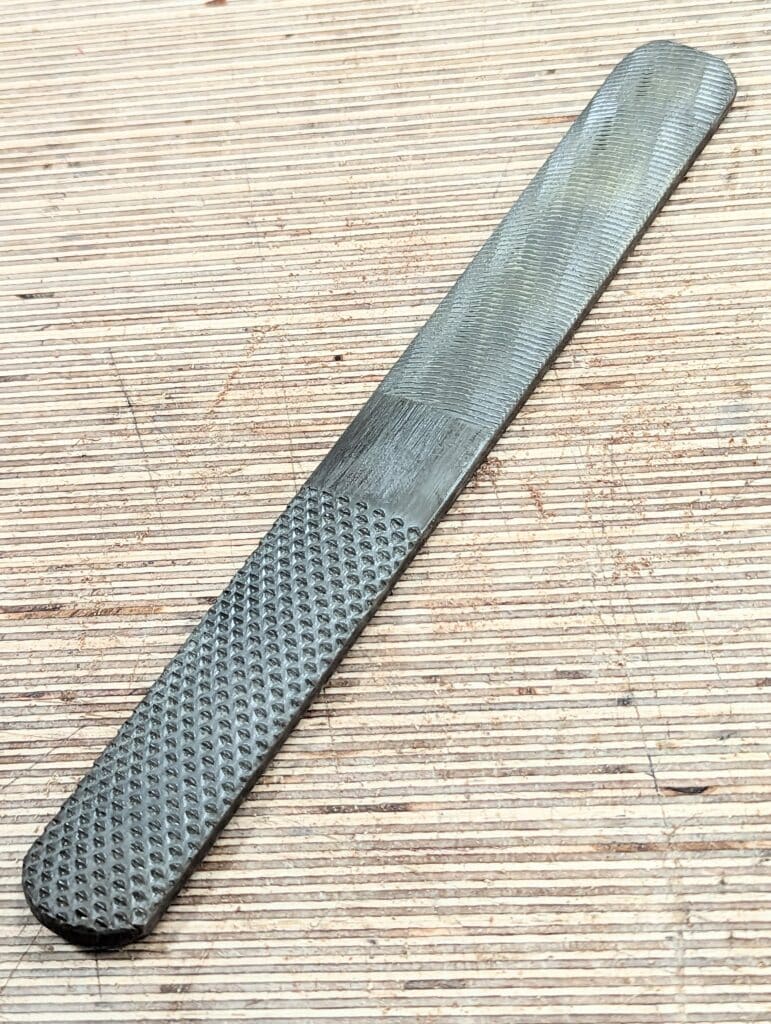
I remember the day I switched from the four in hand to the Auriou cabinet rasp; the 12″ #10 stitching. It was a night and day experience yet I also recall a four-in-hand version that was truly well made and extremely handy all in a single tool. They rapidly declined in quality and this was a direct result of cheaper imports robbing decent makers by coming in at less than half the price with a look-alike that fooled everybody into thinking they were in fact getting one and the same tool. By the time everyone realised the difference, the good makers were gone. That said, four-in-hands as distinct from farrier’s rasps do work and work well enough. They are just not as good as the premium versions. They are ideal for seeing if what you want to use rasps for will be a part of your future; we often use a transitional tool like this before we spend money. on extra special ones.
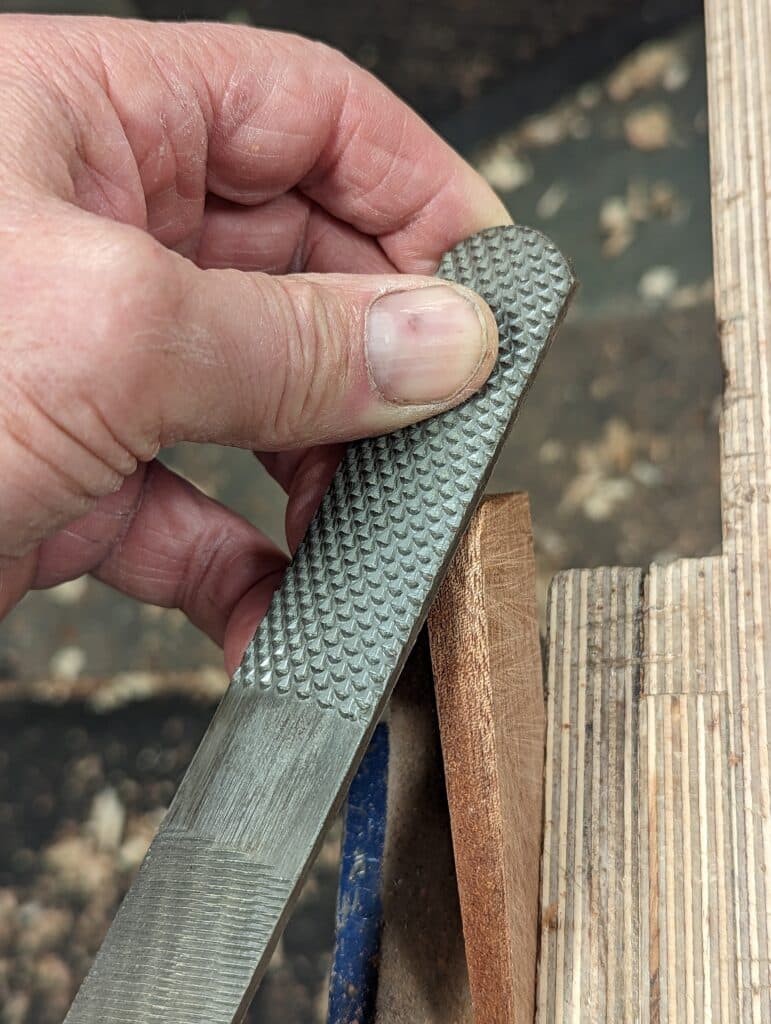
It was sending a new woodworking maker to buy a £140 rasp that caused me to rethink things. The farrier version is certainly still a good fit for starting your kids out or if you are only making a few items requiring shaping by this method of hand work. Anyone reaching into the future for long-term shaping will now know to consider the hand-stitched versions and there are different makers out there who make very nice rasps, some from places like the Czech Republic are really excellent and are usually less expensive too. I own a couple and enjoy them.
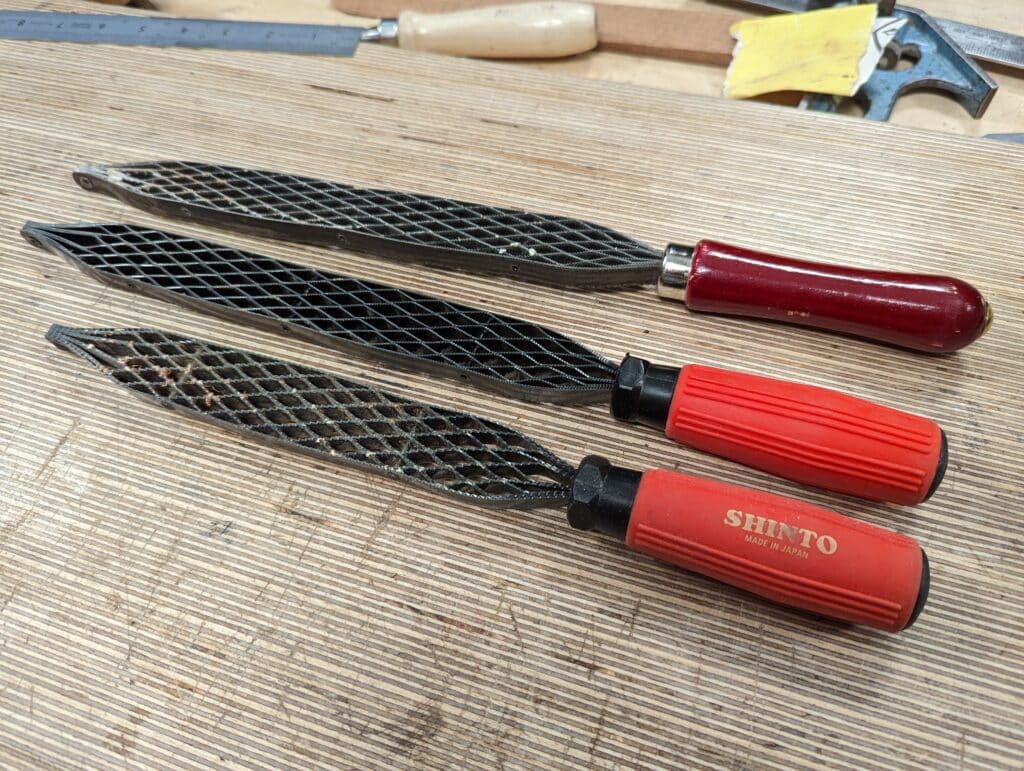
I bought the Shinto saw rasp as an alternative and have tested it out for a good length of time. I used one in place of my Cabinet Rasp to try to work out its longevity, functionality and so on. Its main downfall is there is no round face to it so it is mostly useable on flat and convex surfaces. Hollowing is out of the question. Its advantage is that it has both coarse and fine in a single rasp. As far as price goes, the price has risen. It seems it will cost you somewhere around £30-35. After a year’s use, it has less bite than the Auriou, to the point that I ordered its replacement. Comparing the 13 years of use with the one year of the Shinto leans towards getting one-quarter the time I got from my Auriou but my Auriou is still going and I prefer the heft and feel of it generally. So, my conclusion is that there really is little difference in overall cost except that we do have the round back to the Auriou and the coarse and fine faces of the Shinto.
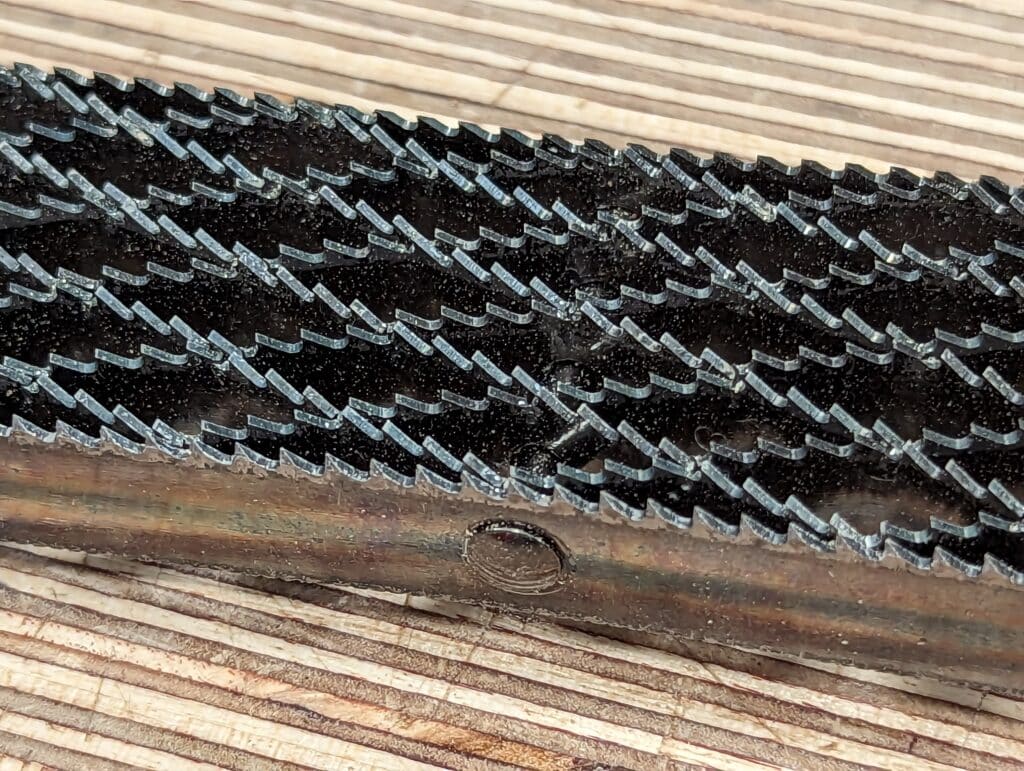
For the main part, I can live without the coarse side of the Shinto though I can see it being very handy now and then for taking off material in quantity and quickly. What I cannot live without is the round back of the Auriou or other makers I have. A quick flip of the wrist to deal with hollows and rounds equally well with the same fineness. But I am content now that I know it is not an either-or. I can extend the life of my Auriou and double or even triple its longevity by using both sides of the Shinto saw rasp.
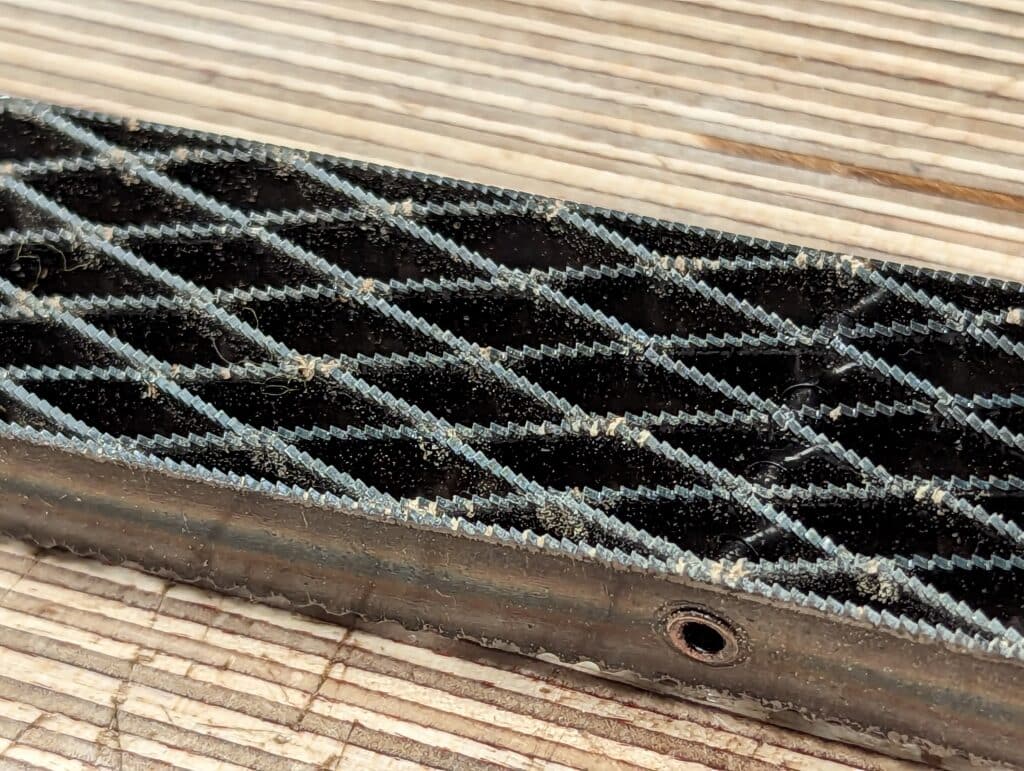
Conclusion: After long-term testing, I enjoy owning both the more expensive rasps and the Shinto but the four-in-hand- meets different criteria. If you start with the four-in-hand you will lose nothing starting out and it is good for children to work with. Then consider the Shinto if you think you will have no need for the round face of a proper rasp; this could be a stepping stone to owning a premium rasp. There is true joy in owning an Auriou and keeping it for best work long term. I suspect for most woodworkers with limited time of a day a week at the bench that this will become a lifetime tool for them


Hi Paul. Many thanks for sharing this advice. I’ve been using a Czech cabinet makers rasp which is a bit too coarse. You mention that your Auriou cabinet makers rasp is a 12” 10 grain. Would you mind sharing the specifications of your smaller Auriou rasp also? From the picture I’m guessing it’s a 7” 13 grain modeller’s rasp, but it’s just a guess. Many thanks in advance!
It is the 7″ 13 grain, Bob. Very nice in the hand.
Agree about the four-in-hand. A larger, good quality version of that would be immensely useful.
I have all the rasps and files I have bought and restored. I need to learn how to make nice handles like those Auriou rasps! Could you make a post or video on that topic? Or do you purchase handles?
Good day Paul,
I have had the Nicholson brand, #49 and the #50 for nigh on 40 years now and they are a fantastic set of rasps. I have two sets and obviously the older set gets the brunt and I use the newer set for the finer shaping process.
Thanks
John
I at once time could recommend Nicholson files when they were made in the USA but since they import them now from who knows where they have compromised being the best of the best to now being the worst of the worst so I can no longer give them any credit for being good quality.
For me, the four in hand is extremely uncomfortable to use. I got one to try, and another free with the purchase of some other products from Woodcraft. I ended up covering one end of each with strong tape so I could hold them without the rasp side biting into my hand.
Maybe it’s you. I have taught many dozens of children using the four-in-hand and then hundreds of adults with no such issues so I say that because no one should be put off them. And it might be better to use a cloth glove with a rubberised palm grip instead of taping the tool and making one end useless.
Hi Paul thanks for your reply and insight. I do value your advice. In this case, since I had two identical tools, I taped opposite ends so I still have full function. If they dull, I can swap ends. Really not an issue, and they do perform well.
Yep, same deal with the four in one rasp. Bites your palm a bit. Might be the crappy Nicholson brand, too, if you are in the US. Not bueno. Maybe you are gripping hard on it?
Hello, Michel Auriou doit avoir le sourire aux lèvres !
oui je pense..
I have 3 babbet files that I use for woodworking. They have very sharp curved “teeth” fully acrossed the face of the file, round on one side flat other side, like a series of mini plane blades. they leave a very smooth finish. I got these from an industrial supply house years ago don’t know if they are even made anymore?
Are the Tome Feteira portuguese hand stitched rasps junk or good? They look good to the untrained eye…but I’m not a pro.
I have a very nice Tome Feteira that is a joy to use, but I think they are not truly hand stitched I think it is some sort of machine generated randomness. I could be wrong. Anyway I got one that was very nice to use. Then I bought some of their saw files and they are terrible.
An adequate stepping stone but not equal to the truly or fully hand-stitched versions I think. Remember that many things handmade are machine-made in that they are held or fed into a machine for a mechanised impulse: not one and the same at all. In the USA, for instance, if a human hand passes a piece of wood into a machine of any kind then it can be called handmade. Auriou and Logier are still stitched by hand and eye so a hand-held hammer and chisel point. Two hands, one bar held by strap to a cushion.
Thank you, sir! They lied to us again lol.
Do you use and recommend any rifflers for wood carving?
I have them and never use them. I believe that that is because I use carving gouges and chisels for more detailed work and they give me a crispness I cannot get with any kind of abrading which rasps do. Rifflers are more welcome on decorative stonework used by stone masons.
Mr. Sellers, I am wondering if the problem with the softer rasps is the quality of the steel, or the tempering process, and if they can be rehardened before use?
It’s not unusual for manufacturers to build in obsolescence so that customers go back time and time again and then more often too. Think early modular homes of the 1960s on up through the decades as in mobile homes USA. Low-cost housing but at a price.
I bought some Auriou rasps after seeing you use them nearly a decade ago. They are lovely to use. I bought one called “The Hog”, which blasts through material, but really wasn’t a necessary purchase in hindsight. I have a curved and a flat one too, 12″. They just work really, really well. I made a box to cover some pipework at the weekend, and added a somewhat unnecessary handle just so that I could use the rasps to shape it! One of my best woodworking purchases.
Thank you Paul. When you first started using the Shinto rasp on your videos, I resurrected the two I own and started using them again as you suggested. They work very well, and I have found coincidentally as did you, that using them for the “rough in” part first, then switching to my Auriou Rasps works perfectly for me and really extends the life of my Auriou rasps. I have owned my two Auriou rasps for a number of years and they still work perfectly. My wallet swallowed very hard when I purchased them, but there is nothing quite like them in performance. No regrets.
Cheers.
Michael
Dare I mention Surform?
Only if you don’t try to compare them with these two rasp types, especially the Auriou. Nowhere near the quality or the performance. Not even close.
You reminded me that at one time I had one of the 4 in 1 rasps, long since lost. I remembered that my local go to place for old tools has a box of old files. I rumaged through it today and found a replacement. Felt sharp with a crude thumb test and cuts fine when I got it home. Slightly different in that the curved side has 2 rasps and the smooth side 2 files.
I got gifted a Four in hand from an old friend many years ago . he must of had it for near on 50 years, so you know it is of the old design and quality. I still use it from time to time but also have three different size Auriou which are my main use.
One other alternative to hand stitched is Kutzall. Ignoring the cringe worthy name and looking beyond their reputation as a maker of rotary cutters and burrs, they make rasps – coarse and fine. In two lengths and three shapes. Their process makes very durable tools and they make rasps with “random” pattern of “teeth”, which tends to not create as much parallel tracks on the workpiece. I just recently discovered their rasps and now own three of those. So far I like them a lot, but it is not a long term opinion. One drawback that I noticed is the Kutzall rasps are bit harder to clean and they tend to gather wood in them faster. Kutzall, says use propane torch to “clean” them, but I have not mustered the courage yet.
Ever since I’ve read somewhere here (very wisely put) that “the worse thing for a rasp/file is another rasp/file against it” (paraphrased)… I feel UNWORTHY of acquiring a good rasp/file.
So I ask you, fellow wood-friends:
How do you store yours?
D’you hang them, roll’em in a leather pouch or…?
Help me fix my wicked ways, I only own old very worn rasps/files which one way or another ’appeared’ here, or newer laughable quality ones, all mingling in a drawer.
Regards,
Paulo
I’ve recently purchased 2 Auriou rasps and enjoy using them. How do you clean and care for them? I cannot find any good information on this. Thanks.
I use a plastic bristled stiff brush that flicks out any wedged fibres. It looks like a crudely made oversized black tooth brush but a nail brush and a veg cleaning brush works well too.
I have quite good experience with the Iwasaki carving files. Come in many versions, and work a bit like planes, creating small shavings, easily removed, or not necessary at all.
One must mount a handle.
Cost is mainly 20-30 euros.
Mine are still sharp after 5-6 years.
HI Paul .
I purchased a Shinto and found that i do not use my other files as much now .i was thinking that i could make a Shinto using some axe saw blades bolted together at the ends ,you need about ten they work very well as long as you hold the middle with something.
Some things I sorta don’t go along with and this is probably one of them. I think a lot more went into the development of the production to come in at the price they do, much more than just, “using some axe {hack] saw blades bolted together at the ends…” I doubt two sizes of blades would come in at the price of buying them and then a day’s work to finesse something that is so truly fit for purpose.
I wanted and purchased a whole set of Auriou rasps from Lie Nielsen here in the states many years ago. There are two videos on the internet. One from Christopher Swartz explaining how and why the hand stitched rasps work so well. The other is a video from Auriou themselves showing the entire process of how their rasps are made. A most enlighteningly wonderful and interesting video. This from the forging, hand stitching, and even the tempering of them. I have since at one time received an email from them asking for donations to stay afloat. Mentioned this to Lie Nielsen and they said they received the same email. Not sure if they are in business anymore, but I most certainly hope so. This was well before the pandemic. I, too, absolutely love them.
I can only concur to you Paul, the quality of Auriou hand-stitched rasps is incredible, and one should try it to really understand how wonderful these tools are.
I own a n°9 (“Râpe fauteuil L. 250 P. 9” on their online shop), and it is truly mesmerizing how easy it hogs through wood, lets you shape your piece in a breeze, and only requires *minimal sanding* afterwards.
Yes it is expensive, but it is truly a tool you will keep your whole journey in woodworking, especially if you treat it with care 😉
(btw I’m French, but I would equally praise this brand if it was produced in any other country ;))
Marc,
i bought a starrett square after using el cheapo combination squares. Sometimes you just can’t beat a Cadillac version of a tool (the high end, best in class). plus you just feel good using it. what is that worth?
Jeff D
But remember there are many secondhand versions for a fraction of the cost that match the Starretts. I own Starretts but seem always to reach for my Rabne Chesterman, Browne and Sharpe and a couple of others. They don’t look as good if they have been used and left around but I have yet to find one that didn’t come to me square. Just another option. A friend bought a vintage version secondhand that was unused. very lovely.
great info. i get lured in by pretty tools. even those cute brass mallets lol
in the usa there is a cult of starrett and lee valley aka veritas
I want to order a new, flat cabinet file to replace my old one. Three lengths are sold. My question is how to measure it to get the same size. Is it correct to measure its entire length or from that end to where it narrows down for the handle to slip onto?
Length will be close to the rectangular surfaces’ useable surface. Or you could just order a ten inch. Anything shorter is too short and longer too long.